Business Workflows On Steroids: What is Robotic Process Automation (RPA)?
Curious about the future of productivity? Imagine a world where your daily digital tasks are effortlessly handled by robots. Discover how Robotic Process Automation (RPA) is freeing up valuable time.
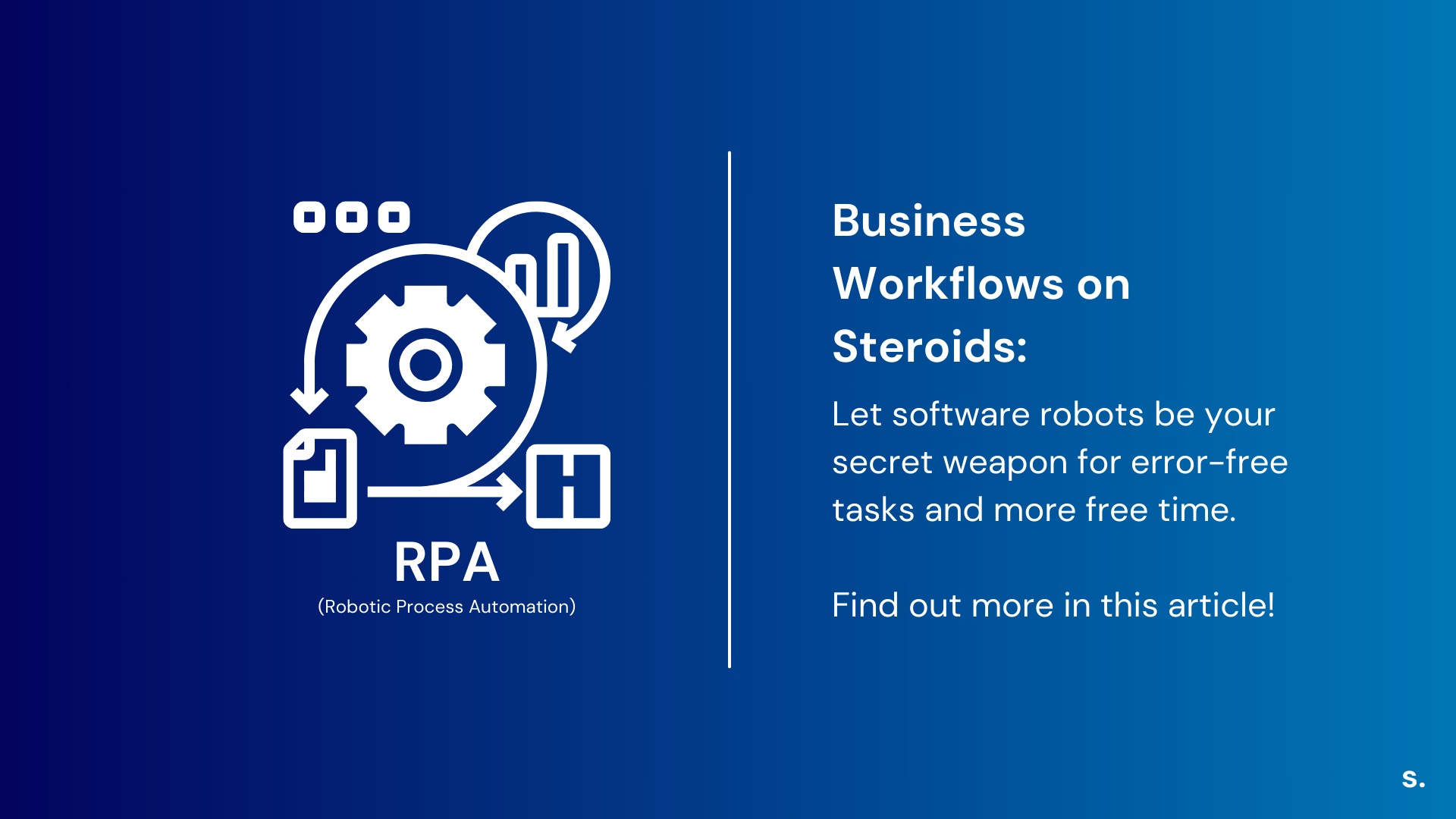
RPA uses software robots or 'bots' to automate repetitive, rule-based tasks traditionally performed by humans. This includes data entry, transaction processing, logging into systems, and much more. This technology helps companies save a huge amount of time. The market for RPA is projected to grow by 33% in 2030.
I must admit, today's topic really gets me pumped because I am an incredibly lazy individual when it comes to administrative tasks.
Like, super lazy...
Automating workflows has always been a huge interest of mine. It doesn't matter if it's in my personal life or at work.
Coming up with ways to streamline tasks has helped me focus on more important things, such as running this blog.
Today I want to introduce you to a technology that will do the work for you.
In short, Robotic Process Automation (RPA) allows software users to automate tasks.
As an increasing number of companies recognize the benefits of delegating mundane and repetitive tasks to automated software robots.
It is likely that we will see a more extensive adoption in the years ahead.
I hope you can gain a lot of new insights from this article. Let's get right into it:
What is Robotic Process Automation?
Efficiency and productivity.
Businesses across the globe streamline dull tasks to work faster, simplify complex processes, and remove unnecessary steps that hinder employees from strategic work.
Robotic Process Automation (RPA) aims to solve manual and uninteresting assignments.
The power behind RPA lies within software robots which can be programmed to perform specific tasks without human intervention.
This automation solution helps create smooth workflows, making them not only efficient but also cost-effective.
What are Software Robots?
RPA utilizes software robots to automate manual, high-volume, and other repetitive tasks that were traditionally performed by humans.
These bots interact directly with applications just like a human would.
They type, click, login, move files, fill in forms, extract structured and semi-structured data from documents, etc.
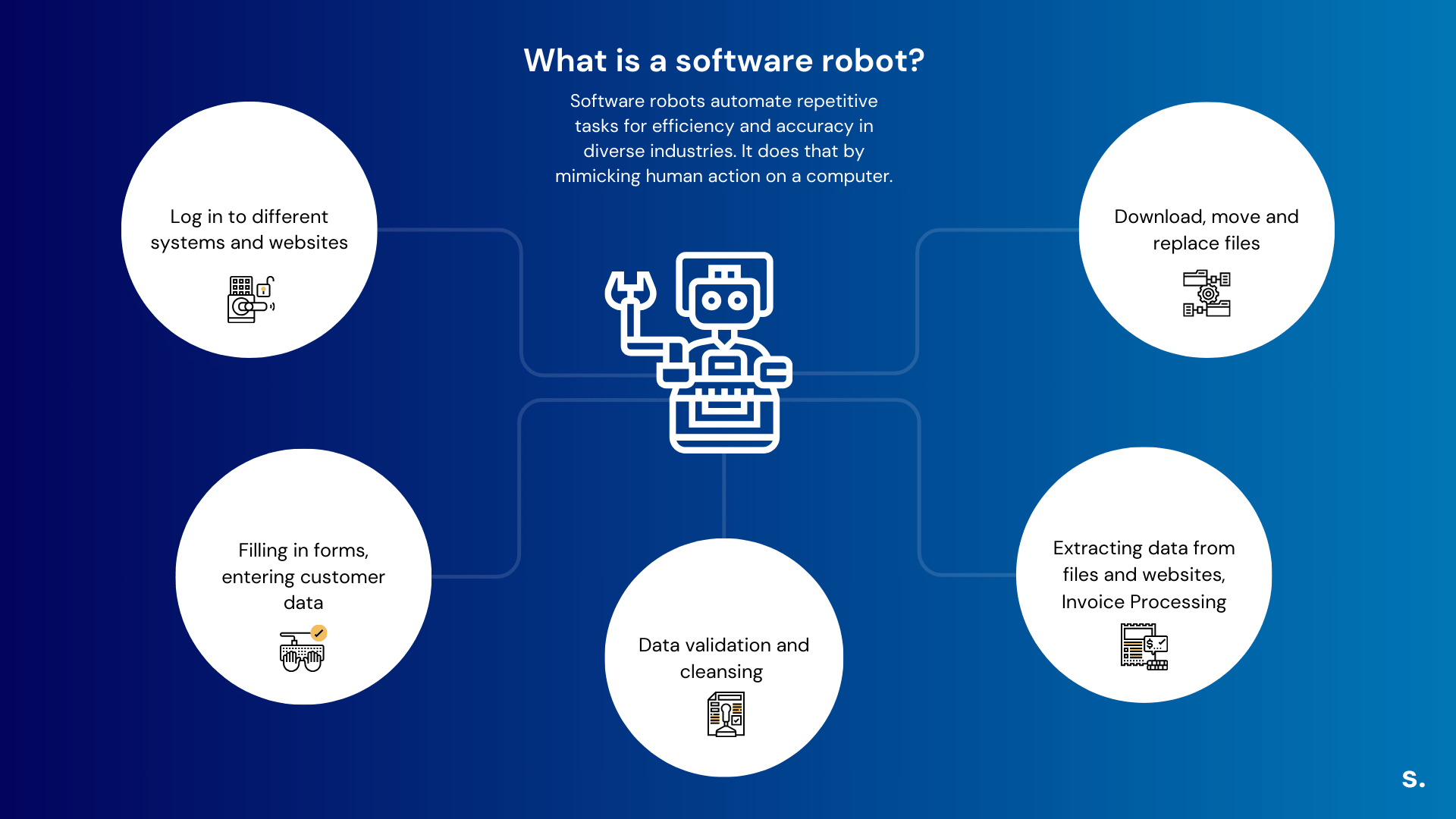
Several powerful tools are available for implementing RPA including UiPath, Blueprism, or Automation Anywhere.
Each tool has its unique features.
But all aim at automating workflows to streamline business operations and accelerate digital transformation.
It's also worth mentioning that some of these tools can be used without prior coding knowledge due to their low-code interfaces.
Benefits of Robotic Process Automation
A key strength of RPA is its noninvasive nature, allowing rapid implementation into existing systems with minimal disruption.
In other words, companies can start reaping immediate benefits while laying the groundwork for future growth and digital transformation.
Here are some of the benefits listed for you:
Mundane Task Removal
Implementing robotic process automation increases employee satisfaction by removing mundane tasks from their workdays.
Thus increasing overall productivity.
Accuracy
Human error inevitably creeps into any manual process.
Especially those involving high-volume data entry or complex calculations.
However, when robotic automation tools handle these jobs, errors become virtually nonexistent, leading to improved outcomes across all aspects of business operations.
Cost-Efficiency
Labor costs can be significantly reduced with the utilization of bots, as they have the ability to work around the clock, 24/7.
Scalability
RPA possesses the capability to effortlessly adjust its capacity according to operational requirements.
Allowing for seamless scaling up or down as needed.
Compliance and Auditability
RPA bots have the capability to generate comprehensive logs that document their actions in great detail.
Allowing businesses to maintain regulatory requirements effortlessly.
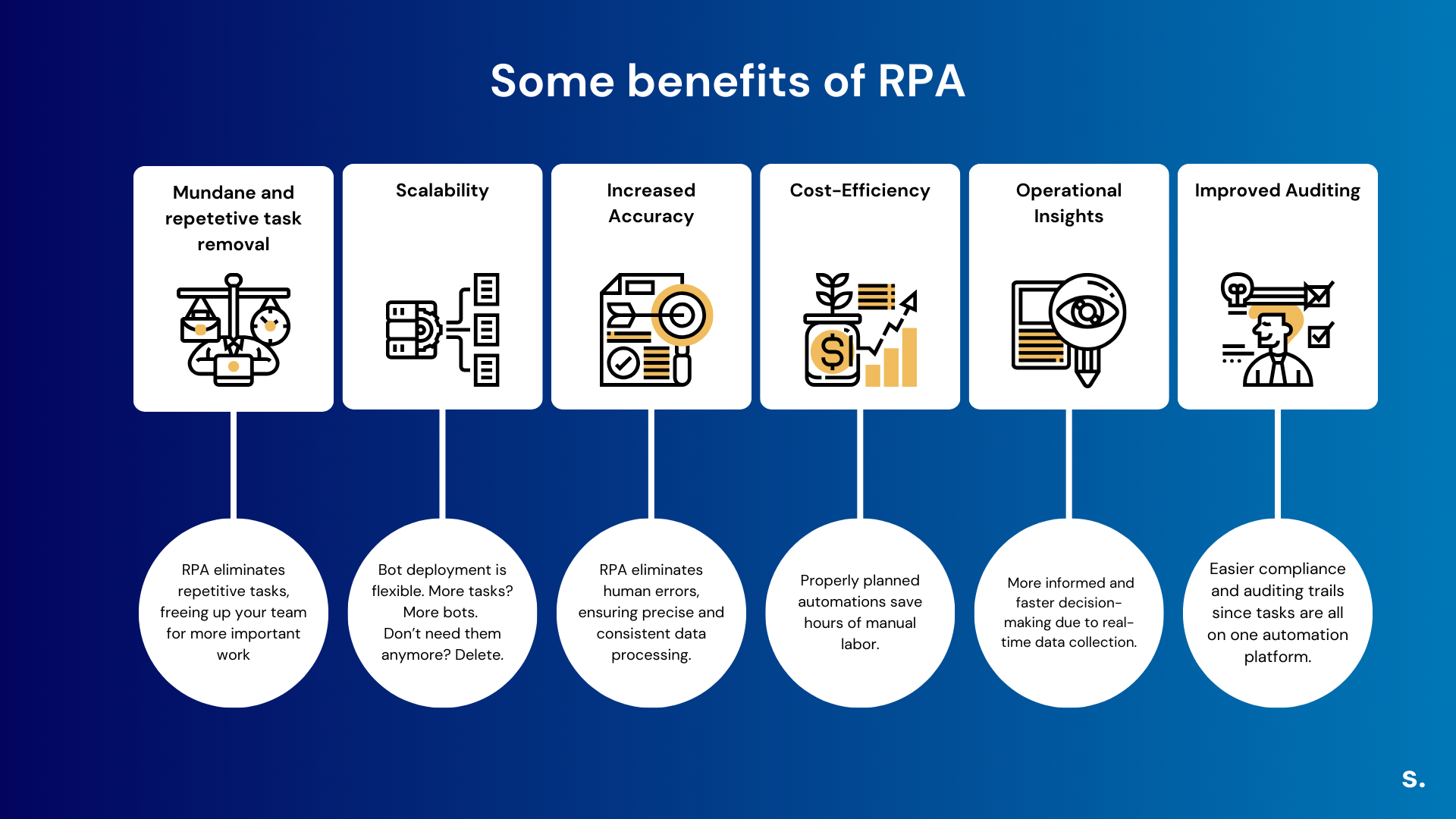
Challenges and Limitations of RPA
Process Complexity
RPA is well-suited for tasks that follow a set of predefined rules.
However, it may not be the best solution for processes that are intricate or involve a high level of complexity.
Change Management:
Despite its potential, one significant limitation of RPA is the challenge of change management.
Businesses often face resistance from employees unaccustomed to or wary of robotic automation in their workflows.
Maintenance:
RPA Bots struggle with changes or updates in the applications they interact with.
Security Concerns:
While RPA can streamline many business processes.
It also raises security concerns, as improperly managed bots could become potential vectors for data breaches or unauthorized access.
Common Use Cases for Robotic Process Automation
Currently, RPA is utilized in various industries and helps them streamline repetitive tasks.
Companies in sectors like finance, healthcare, manufacturing, public services, retail, and more are adopting this technology to enhance efficiency.
P.S. I use the last example on a daily basis. All I can say is I'm glad I automated it. Saved me so much time.
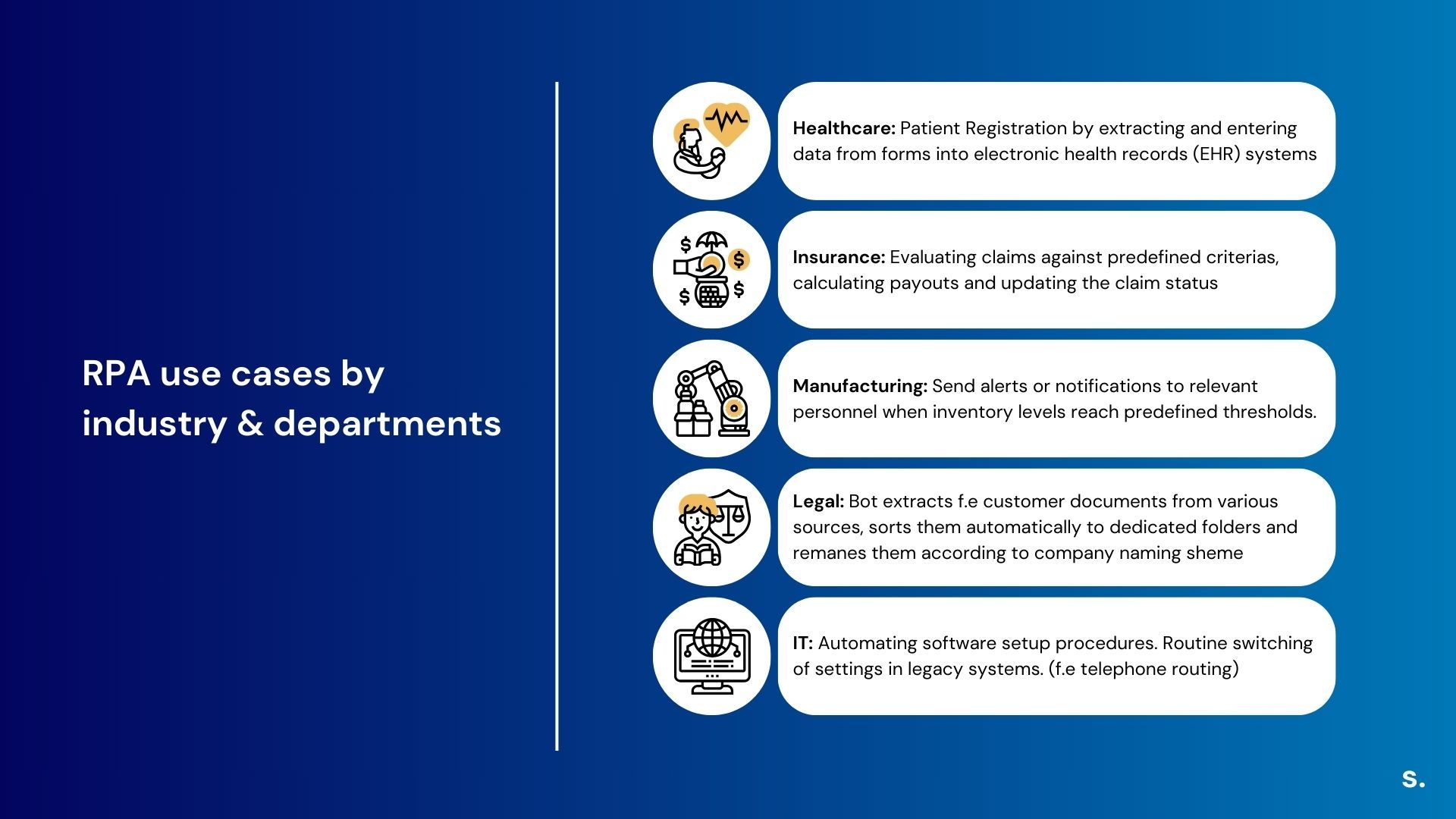
The Growing Market for RPA
If you're wondering just how fast the robotic process automation software market is growing, consider this:
In 2018 alone, its expansion outranked all other segments within enterprise software. That's no small feat.
Source: https://www.gartner.com/en/newsroom/press-releases/2019-06-24-gartner-says-worldwide-robotic-process-automation-sof
This isn't merely a passing trend either.
The future looks even brighter with projections estimating that by 2030, the global RPA market will reach staggering heights - valued at $13 billion.
Source: https://www.statista.com/statistics/1259903/robotic-process-automation-market-size-worldwide/
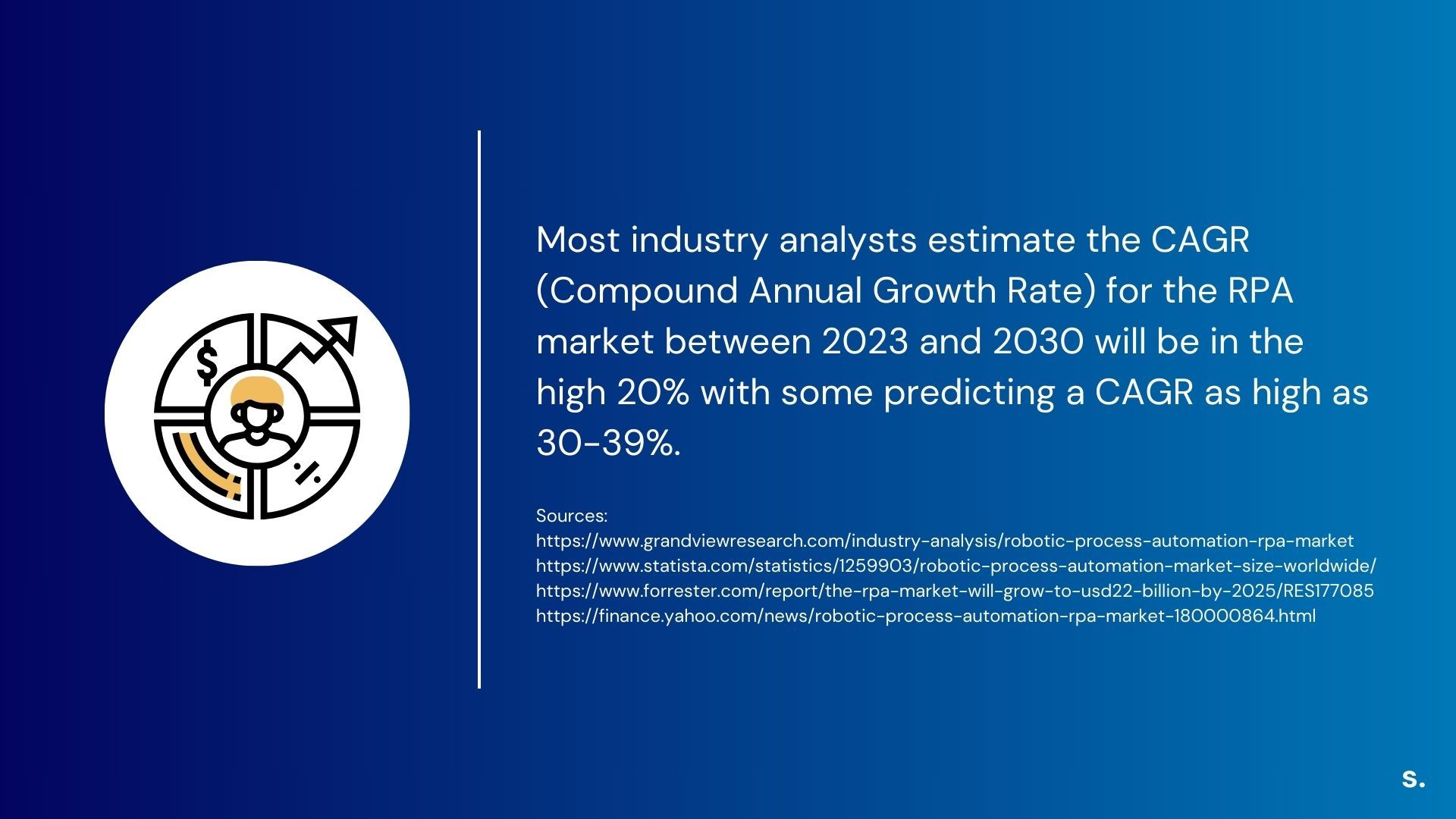
AI and RPA
RPA is not AI.
However, the combination of RPA and AI can create intelligent automation.
Which can handle both high-volume, business-rules-driven, repeatable processes.
And cognitive processes that require higher-order AI skills.
The AI market is huge.
We will likely see new AI-powered RPA features in the coming months. (UIPath ForwardVI automation event)
AI Market Size by 2030-2032
- Statista: Nearly $2 trillion by 2030
- MarketsandMarkets: $1,345.2 billion by 2030
- Grand View Research: $1,811.75 billion by 2030
- Precedence Research: $2,575.16 billion by 2032
- Fortune Business Insights: $2,025.12 billion by 2030
FAQs in Relation to Robotic Process Automation
What are your thoughts about Robotic Process Automation?
Robotic Process Automation (RPA) is a game-changer, automating mundane tasks and freeing up human resources for more strategic roles.
It's an essential tool for businesses seeking to streamline operations and boost productivity.
What does Robotic Process Automation do?
RPA uses software robots or 'bots' to automate repetitive, rule-based tasks traditionally performed by humans.
This includes data entry, transaction processing, responding to simple customer queries, and much more.
What are examples of Robotic Process Automation?
In finance, RPA can automate account opening processes.
In insurance, it simplifies claims processing.
In retail, it manages orders efficiently.
While healthcare leverages RPA for information management and insurance claim processing.
What are the future trends for RPA?
The future of RPA lies in its integration with AI technologies like machine learning and natural language processing.
This combination will enable even smarter automation capabilities across various industries.
